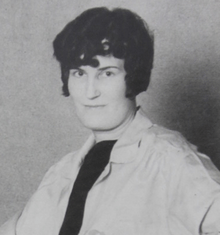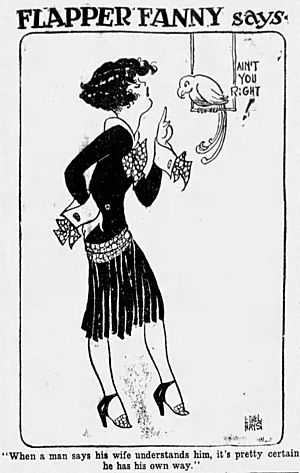Ethel Hays facts for kids
Quick facts for kids Ethel Hays |
|
|---|---|

Hays in her studio, c. 1930
|
|
| Born | March 13, 1892 Billings, Montana |
| Died | March 19, 1989 (aged 97) |
| Nationality | American |
| Area(s) | Cartoonist, children's book illustrator |
|
Notable works
|
Vic and Ethel, Flapper Fanny Says, Raggedy Ann |
| Signature | |
Ethel Hays (born March 13, 1892 – died March 19, 1989) was an American cartoonist. She was famous for her comic strips about flappers in the 1920s and 1930s. Her art style was called Art Deco. Later in her career, during the 1940s and 1950s, she became a very skilled illustrator for children's books.
| Top - 0-9 A B C D E F G H I J K L M N O P Q R S T U V W X Y Z |
Ethel Hays: A Creative Life
Early Artistic Journey
Ethel Hays was born in Billings, Montana, on March 13, 1892. She grew up there. After high school, where she drew for the school newspaper, she studied art. She went to the Los Angeles School of Art and Design. Then she attended the Art Students League of New York.
She even won a special scholarship to study in Paris at the Académie Julian. But World War I started, so she couldn't go. At first, Ethel wanted to be a fine arts painter.
From Painting to Cartoons
Ethel learned how to paint "pretty pictures." But she soon found out that wasn't her true calling. During World War I, she taught painting to soldiers who were recovering in hospitals. She noticed her students were more interested in learning how to draw cartoons.
So, Ethel decided to learn cartooning herself. She took a special course by mail from the Landon School of Illustration and Cartooning. She stayed a few lessons ahead so she could teach her class. In this setting, her way of drawing beautiful women became very popular.
Drawing for Newspapers
This experience with cartoons changed her career path. Soon, Ethel Hays got a job as an illustrator for the Cleveland Press newspaper. The person who designed her cartooning course, Charles N. Landon, helped her get the job. He later praised Ethel Hays in his magazine ads. He said she was one of his "successful comic strip artists."
Ethel's first work at the Cleveland Press was for a popular section called Vic and Ethel. This section featured funny stories and comments about society. It included stories of daring adventures and interviews with famous people. Ethel's cartoons went along with these stories.
Her first comic strip for Newspaper Enterprise Association (NEA) was based on this feature. It was simply called Ethel. In this strip, Ethel continued to show the exciting time when women "bobbed their hair and took up active sports." Even early on, her drawing style was "polished and breathtakingly lovely."
Ethel Hays also drew a famous one-panel cartoon series called Flapper Fanny Says. This was also for NEA and started around 1924. A Sunday page for the strip began in 1928. This panel showed a flapper drawing with a clever saying. Ethel "moved away from the fancy style of Nell Brinkley." She drew women who looked more modern, with short hair, and some even wore pants.
Ethel Hays got married in 1925 to W.C. Simms. She kept using her maiden name, Hays, for her artwork. By 1928, she was a mother. After her second child was born, her daily work became too much. So, she handed Flapper Fanny Says over to another artist, Gladys Parker, around 1931.
Even with less time, Ethel Hays still illustrated many stories. Between 1931 and 1936, she drew for at least 17 stories by the well-known author Ellis Parker Butler. These stories were sent to many newspapers. Ethel also created other art for NEA. This included full-page drawings for Every Week magazine, a Sunday newspaper extra.
Her last comic strip for NEA was Marianne, which started around February 1936. It appeared once a week. A comic strip historian named Allan Holtz said, "While the art was classic Hays, the jokes were just like those from a joke book. You could tell her heart was no longer in it." Her last drawing for Marianne was on December 26, 1937.
Illustrating Children's Books
From 1938 to 1940, Ethel Hays worked for the Christian Science Monitor. She drew cartoons for a series of poems called "Manly Manners." A children's book with these drawings was later published. During this time, her art was also featured on a calendar for 1939. These painted pictures of children playing showed the style she would use in the next part of her career.
Ethel had drawn for books early in her career. But after leaving newspaper comic strips, she started working more on children's books. She illustrated many nursery rhymes, Christmas stories, and alphabet books.
Some of her most famous work was for Raggedy Ann and Andy books. She worked for the Saalfield Publishing Company. Saalfield got the right to make Raggedy Ann storybooks, coloring books, and paper dolls in 1944. Most of the artwork was done by Ethel Hays. Her "energetic, curvy style perfectly captured the fun and spirit of Gruelle's characters." Since she was trained in painting, she was very good at creating these colorful artworks.
In the 1930s and 1940s, Hays also illustrated Puzzle Pages for McCormick-Mathers, a publisher. Puzzle Pages was a series of workbooks for schoolchildren. These pages included sections for reading and writing. They also had pictures and words for cut-and-paste activities. Students could color in Ethel Hays' illustrations.
Her Lasting Impact
Ethel Hays has been called "one of the most successful women cartoonists of the 1920s." A comics historian, Trina Robbins, said that Hays was "without a doubt the most brilliant of the women cartoonists influenced by Nell Brinkley." Other artists like Russell Patterson and John Held, Jr. also influenced her early work. The artist Roy Crane was influenced by Hays, especially in how he drew beautiful women. Ethel Hays' many newspaper drawings helped make the "flapper" fashion style of the 1920s and 1930s very popular.
She continued to create newspaper and book illustrations for many years. Some sources say she retired from commercial art in the 1950s. Others say she worked into the 1960s. Ethel Hays passed away in 1989, at the age of 97.
Images for kids
See also
 In Spanish: Ethel Hays para niños
In Spanish: Ethel Hays para niños


